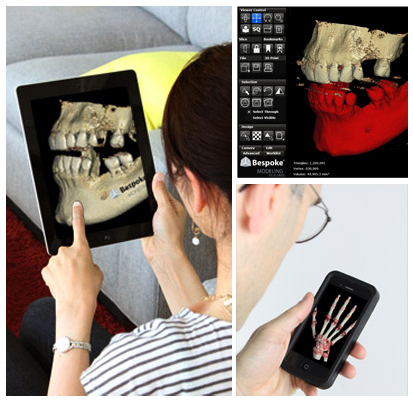
3D System’s Bespoke Modeling gives medical staff the chance to view and share medical models in 3D. Courtesy of 3D Systems.
Latest News
September 30, 2013
It’s entirely possible that additive manufacturing (AM) has made a bigger impact in the medical field than it has in more purely mechanical fields, such as aerospace. Dentists and doctors benefit from the technology’s flexibility by being able to design medical implants and devices on a case-by-case basis, and in a timely fashion.
3D printing has also found a place in pre-surgery prep and training with the assistance of AM-built models of hearts and brains using CT data to build the models. 3D Systems is hoping to tap into the 3D modeling aspects of medical AM with its new Bespoke Modeling program. The new service is a cloud-based program, with a minimal monthly fee, that allows users to upload data, view 3D models and either order a print, or send the data to a printer in-house.
The service is fully automatic, and builds models based on CT, MRI or ultrasound data without requiring vast amounts of CAD expertise. Bespoke Modeling colors the model based on material or tissue density, and users can filter the results further to focus on specific areas of interest. The cloud-based model also makes information easy to share with colleagues.
Bespoke Modeling is compatible with popular web browsers, like Microsoft Internet Explorer, Google Chrome, Apple Safari and Mozilla Firefox. It will also be available on iPad, iPhone and Android devices. The service costs $30 a month.
The service has the potential to be useful to educators as well as medical personnel. Models can be built and printed to give students a chance to work with models that are similar to actual human bone. The same models the program produces to assist doctors in planning surgeries can also be useful classroom aids for learning.
“We use 3D-printed models in our educational exercises whenever possible,” commented Dr. W. Paul Brown, a consulting associate professor at Stanford University. “The ability to manipulate a 3-dimensional, digital anatomical model on a computer in Bespoke Modeling and at the same time hold and manipulate a 3D print of the same structure is a unique and useful teaching tool.”
Below you’ll find a short video that demonstrates practice surgical procedures on 3D printed bone.
Source: 3D Systems
Subscribe to our FREE magazine, FREE email newsletters or both!
Latest News
About the Author
John NewmanJohn Newman is a Digital Engineering contributor who focuses on 3D printing. Contact him via [email protected] and read his posts on Rapid Ready Technology.
Follow DE






